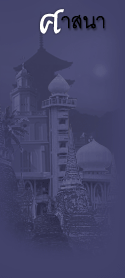 |
 ศาสนาเชน ข้อมูลเบื้องต้น Basics about Jainism
ศาสนาเชน ข้อมูลเบื้องต้น Basics about Jainism

ศาสนาเชน ข้อมูลเบื้องต้น
Basics about Jainism
Numbers: One of the oldest religious traditions of India, Jainism has existed side by side with Hinduism throughout its long history. With fewer than 5 million adherents and comprising less than 1% the Indian population, Jainism has demonstrated a remarkable tenacity and endurance and continues to exert an influence far beyond its small numbers.
ศาสนาเชนเป็นศาสนาเก่าแก่ที่สุดศาสนาหนึ่งของประเทศอินเดีย ที่คงอยู่เคียงข้างศาสนาฮินดูมายาวนาน ปัจจุบันมีผู้ถือศาสนานี้น้อยกว่า 5 ล้านคนหรือน้อยกว่าร้อยละ 1 ของประชากรอินเดีย แต่ศาสนาเชนก็คงทนและมีอิทธิพลต่อสังคมของประเทศอินเดียตลอดมา
Founder: Jainism (the name derives from a Sanskrit word meaning "follower of the Jina, or conqueror") was established in our era by Mahavira ("the Great Hero") in the sixth century B.C.E. In fact, Mahavira is considered only the most recent in a list of 24 such teachers who brought Jainism into the world during previous great cosmic eras of time. These teachers, or "Tirthankaras," taught a path to religious awakening based on renouncing the world by practice of strict religious austerity. Mahavira established a monastic community of both nuns and monks. This community is the oldest continually surviving monastic community in the world.
คำว่าเชนเป็นคำที่ได้มาจากภาษาสันสกฤตแปลว่า สาวกของผู้ชนะหรือพิชิต เป็นศาสนาที่ก่อตั้งในยุคเดียวกับพุทธกาลหรือประมาณหกร้อยปี่ก่อน คริสตกาลโดยพระมหาวีระซึ่งแปลว่าเป็นวีระบุรุษผู้ยิ่งใหญ่ เป็นศาสดาองค์ล่าสุดของจำนวนศาสดาที่มีทั้งหมดมี 24 องค์ โดยองค์อื่น ๆ ที่ได้นำศาสนานี้มาสู่โลกใบนี้มาแล้วในอดีตกาล ศาสนานี้สอนว่าการจะบรรลุธรรมสูงสุดได้ก็ต่อเมื่อคน ๆ นั้นต้องละทิ้งชีวิตทางโลกล่างสิ้นเชิงแล้วประพฤติพรหมจรรย์อย่างสุดกำลัง มหาวีระได้สร้างวัดเพื่อให้พระและนักบวชหญิงได้ ปฏิบัติธรรม และวัดแห่งนี้จัดว่าเป็นวัดเก่าแก่ ที่สุดแห่งหนึ่งของโลกที่อยู่รอดมาได้จนถึงปัจจุบัน
Main Tenets: Jains reject belief in a creator god and seek release from endless reincarnation through a life of strict self-denial. The title of Jina is given to those who are believed to have triumphed over all material existence. As all human activity accumulates karma, the force that perpetuates reincarnation, the only way to free one's jiva, or soul, from the bondage of material existence is by reducing this activity through ascetic practice. In addition, Jainism places a special emphasis on ahimsa ("non-injury") to all living beings. The concern for life is extended to all creatures, even minute microbes that are not visible. The Jain ideal is a mendicant ascetic who takes extreme measures to avoid injuring all creatures. Monks and nuns are sometimes seen with muslin cloths over their mouths to keep out flying insects, and they are enjoined to use small brooms to gently sweep away living creatures from their path, so as to not accidentally crush them.
ศาสนาเชนปฏิเสธเรื่องการมีอยู่ของพระเจ้าผู้สร้างอย่างสิ้นเชิง และศาสนาเชนสอนให้ไม่ติดยึดในอัตตาซึ่งจะเป็นวิถีให้หลุดพ้นจากวัฏสงสารได้ ศาสนาเชนสอนให้เชื่อเรื่องกฎแห่งกรรมและการเกิดใหม่ และสอนว่าการจะทำให้ชีวิตหรือวิญญาณเป็นอิสระจากการเวียนว่ายตายเกิดได้ก็ด้วยการที่จะต้องไม่ติดยึดกับวัตถุใด ๆ แล้ว บำเพ็ญเพียรทุกกริยาอย่างเข้มงวดเท่านั้น นอกจากนี้ศาสนาเชนยังสอนเน้นเรื่องอหิงสา ไม่ทำให้สิ่งมีชีวิตใด ๆ ต้องเดือดร้อนด้วยประการทั้งปวง ศาสนาเชนให้ระวังไม่ทำร้ายแม้สัตว์นั้นจะเล็กมาก ๆ เพียงใดหรือแม้จะเล็กจนมองไม่เห็นก็ตาม และเพื่อเป็นการป้องกันไม่เผลอไปทำร้ายแมลงที่บินไปมา จึงจะพบว่ามีนักบวชชายและหญิงของศาสนาเชนหลายท่านจะใช้ผ้าป่านบาง ๆ ปิดปากเพื่อป้องกันอุบัติเหตุดังกล่าวด้วย
Main Sacred Text: The sacred texts of the Jains are called Agamas. The two main branches of Jainism share many of the same sacred texts in common, but since their split in the fifth century C.E., they have developed different traditions of textual transmission. Both branches claim that authority for the most ancient texts derives from Mahavira, who was in turn enunciating sacred truths that the Tirthankaras before him had taught. Handed down orally in the monastic communities, the sacred literature was not written down until about 500 C.E.
พระธรรมคำสอนของศาสนาเชนใช้วิธีการเรียนการสอนแบบท่องจำสืบต่อกันมาเป็นระยะเวลายาวนานถึงประมาณ คริสต์ศตวรรษที่ห้า หรือประมาณเกือบหนึ่งพันปีต่อมา จึงได้เขียนลงเป็นลายลักษณ์อักษร และปรากฏว่าสาวกของศาสนาเชนได้แตกแยกออกเป็นสองสายโดยต่างฝ่ายต่างก็อ้างว่าคัมภีร์ที่ตนสร้างขึ้นถูกต้องตามคำสอนของพระมหาวีระมากที่สุด
(ข้อมูลได้จากเวบของวัดเชน เมืองฮุสตัส ประเทศสหรัฐอเมริกา)
ข้างล่างนี้คือรูป พระมหาวีระ
ศาสดาของศาสนาเชน
http://www.jain-houston.org/
จากคุณ :
kongsilp2000  - [
10 ต.ค. 50 15:25:22
]
- [
10 ต.ค. 50 15:25:22
]
|
|
|
|
|
|

